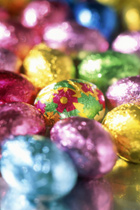How we celebrate Easter today has evolved over many centuries from Pagan, Christian and Jewish roots with various cultural traditions thrown in depending on where you are in the world. Religious culture celebrates the resurrection of Jesus Christ following his crucifixion, while secular culture celebrates the change of the seasons following the Autumn Equinox.
A bit of History
The first celebration of Easter goes back to a pagan festival before the birth of Christ. In a very well-researched article in the English newspaper ‘The Guardian’, Heather McDouggall explains that “The general symbolic story of the death of the son (sun) on a cross (the constellation of the Southern Cross) and his rebirth, overcoming the powers of darkness, was a well-worn story in the ancient world. There were plenty of parallel, rival resurrected saviours too.

“The Sumerian goddess Inanna, or Ishtar, was hung naked on a stake, and was subsequently resurrected and ascended from the underworld. One of the oldest resurrection myths is Egyptian Horus. Born on 25 December, Horus and his damaged eye became symbols of life and rebirth. Mithras was born on what we now call Christmas day, and his followers celebrated the spring equinox.
Even as late as the 4th century AD, the sol invictus, associated with Mithras, was the last great pagan cult the church had to overcome. Dionysus was a divine child, resurrected by his grandmother. Dionysus also brought his mum, Semele, back to life.”
Interesting isn’t it?
Another link with Easter’s pagan past is its timing on the first full moon following the Autumn Equinox. If the full moon falls on a Sunday, the Christian churches delay it a week decreasing the chance of it falling on the same day as the Jewish Passover.
The word ‘equinox’ is derived from Latin and means “equal night”. In our southern hemisphere, the Autumn equinox occurs when the sun shines directly on to the equator and the length of day and night is nearly equal. According to Norwegian company, timeanddate.com AS, “the March equinox occurs the moment the sun crosses the celestial equator – the imaginary line in the sky above the Earth’s equator – from south to north. This happens either on March 19, 20 or 21 every year. On any other day of the year, the Earth’s axis tilts a little away from or towards the Sun. But on the two equinoxes, the Earth’s axis tilts neither away from nor towards the Sun.”
The Bible tells us Jesus’ death and resurrection occurred around the time of the Jewish Passover which was celebrated on the first full moon following the equinox. Although there is no celebration of Easter in the New Testament, early Christians first referred to Easter roundabout 116AD and the name was made official by the Council of Nicaea in 325AD.
Many ancient peoples worshipped the sun celebrating the end of the long northern winter around the Spring (our Autumn) Equinox. Early Christians pragmatically incorporated ancient pagan practises, many of which are still enjoyed today.
Other celebrations around the world on the Spring/Autumn Equinox include:
Earth Day – either a day to celebrate what all peoples of the world have in common: our lives here on Earth or a day to promote the protection and welfare of our planet;
Higan or Higan-e – a Japanese Buddhist celebration of the spirits of the dead reaching the “other shore” of enlightenment or Nirvana after crossing the river of existence and suffering.
Nowruz (No-Ruz), the start of the Iranian New Year – in accordance with the Persian calendar, in a 12-day celebration that dates back to before Islam.









- 11 years ago
Bizarre that you keep mentioning the Autumn Equinox – Easter is a spring festival!